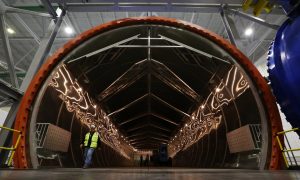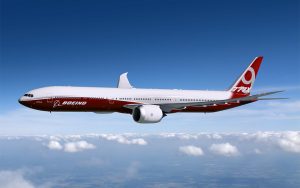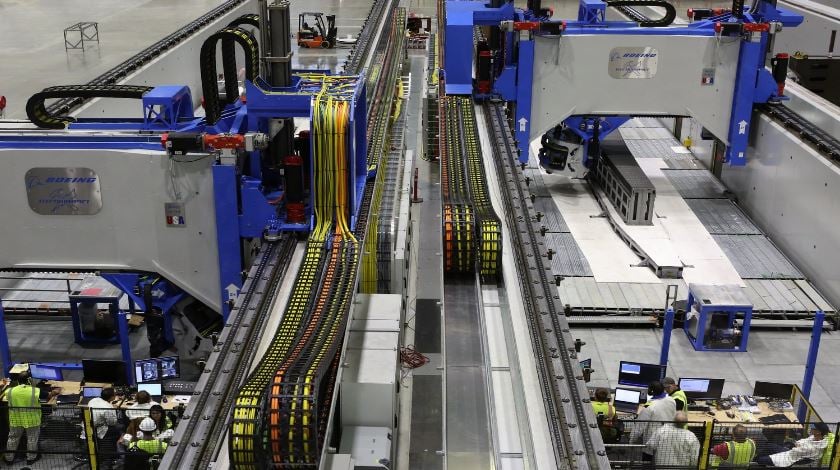Photo: seattletimes.com
Reading Time: 5 minutesJust 14 months after breaking ground Boeing opens its new $1 billion, 1.2-million-square-foot 777X wing center in Everett.
Boeing has begun installing heavy equipment and robotic machines inside its gigantic new 777X composite wing center in Everett, and the first engineers have moved into offices that overlook production.
On Thursday, just 14 months after the groundbreaking, Boeing showed off the awesome proportions of its $1 billion investment.
A huge cylindrical autoclave — a pressurized oven for baking the composite wing parts to hardness — is being cycled through its heating and cooling phases. But even at 120 feet long and 28 feet in diameter, it looks small from a perch at the far end of the building.

On the other side of the wing center, in a “clean room” free of dust and debris and at a tightly controlled temperature and humidity, two big Automated Fiber Placement machines are being tested and calibrated, their robotic heads laying down strips of carbon fiber tape as they zip along.
Layer by layer, these machines, designed and built by Mukilteo-based engineering firm Electroimpact, build up the 105-footlong 777X wing spars — structural beams that form the leading and trailing edges of the wings.
The parts for Electroimpact’s corresponding wing skin fiber placement machines are already in the building, but not yet in place.
“We’ll start to see this building fill up over the next few months and as we get into next year we start to move toward early production parts,” said Eric Lindblad, the Boeing vice president responsible for the 777X wing, before a grand opening Friday morning.
The facility is the major prize Washington state won with its $8.7 billion extension of the aerospace-industry tax credits in 2013. It provides the region a new expertise in composites that could be crucial if it’s to build future aircraft.
Vast space
Inside, the wing center gives an even greater feeling of immensity than the famously massive widebody jet final-assembly plant that it sits beside.
While the 4.3 million-square-foot Everett final-assembly plant is the largest building in the world, its interior space is subdivided into six main bays separated by walls.

The 1.2 million-square-foot wing center — 1,250 feet long, 955 feet wide and 110 feet tall, covering an area equivalent to about 21 football fields — is divided by a narrow, four-story line of offices and storage into just two vast production spaces uninterrupted by columns.
With much of the space still empty, the grand view from an upper story makes workers prepping the floor for incoming equipment appear Lilliputian.
In addition to the wing skins and spars, the wing center will produce the wing skin stiffening rods called stringers.
And in a manufacturing cell designed and built by Spanish engineering firm MTorres — which has established a substantial local facility to support this work — the stringers will be bonded to the wing skins before they leave the building.
Large areas of the floor are set aside for incoming machines that will apply vacuum bags to the parts before they go in the autoclave; other machines will trim and drill the hardened parts after they emerge.
When finished, the four big composite pieces of each 777X wing — upper and lower wing skins with stringers, plus front and rear spars — will then be sent to the building beside it to be assembled into wings, complete with a ladderlike internal structure of aluminum ribs connecting the front and rear spars.
The ribs initially will be produced at Boeing’s Auburn specialty metal-parts plant, with an eye to outsourcing their production later, once the method is perfected and a suitable supplier is identified, said Lindblad, the Boeing vice president.

He said the wing-assembly process will be similar to the new assembly method used for the 737 wings in Renton. The pieces will be laid horizontally so that mechanics can work easily on the structure, as if it were a bench.
And much of the drilling and fastening will be done by customized robots, again designed and produced by Electroimpact, the high-end engineering company led by controversial Chief Executive Peter Zieve.
Boeing has already assembled two sub-scale, 80-footlong wings to test its processes and to provide data for the full-scale models to come.
Full-scale, a 777X wing is 110 feet long, which gives the final airplane an immense wingspan in flight of 235 feet 5 inches, including wingtips that fold upward after landing so that the jet will fit at the airport gate.
(The 777X wing’s 11-foot folding wingtip is a separate structure, which will be built by Boeing in St. Louis and sent to Everett for assembly.)
Difference a wing makes
While the fuselage of the 777X will be longer than that of the current 777-300ER passenger jet, it’s otherwise similar and will be made from aluminum. The major difference in the 777X structure is the composite wings. The current 777 carries 365 passengers. The new 777X will carry 408.

But the two jets will weigh the same and the 777X will be 20 percent more fuel- efficient, Lindblad said.
One component of the added efficiency is new engines, the advanced GE9X.
The other two components of efficiency derive from the wing: lower weight and better aerodynamics.
The composite material is lighter than metal, and the composite manufacturing method allows Boeing to create a more slender, more aerodynamic wing shape.
Lindblad also offered a glimpse of where Boeing stands in development of the new jet, scheduled to enter service in 2020.
He said Boeing has begun detailed design of the 777X parts, a process that will continue into the middle of next year.
Some parts that require an extra-long lead time are already being produced. Lindblad said a heavy-metal forging that’s part of the 777X landing gear was delivered last week to Boeing Portland.
The first completed 777X will likely roll out in 2018. Lindblad said that although Boeing aims eventually to reach a 777X production rate equal to the current 777’s 100 jets per year, that won’t happen by 2020.
He said production of the current model 777 will slow, and the 777X rate will rise until eventually the older version is phased out.
As he spoke, the acres of empty space around him suggested the scope of Boeing’s plan to ramp up the 777X rate.
While there’s just one autoclave in place, there are positions in the floor for two more. Lindblad said the second one won’t be needed until close to 2020.
Likewise, while two Electroimpact wing spar fiber placement machines are in place now, there are concrete plinths built to hold six.
In the meantime, Lindblad said, “we’re excited about going through the details of building the first set of parts and putting our first airplane together.”

